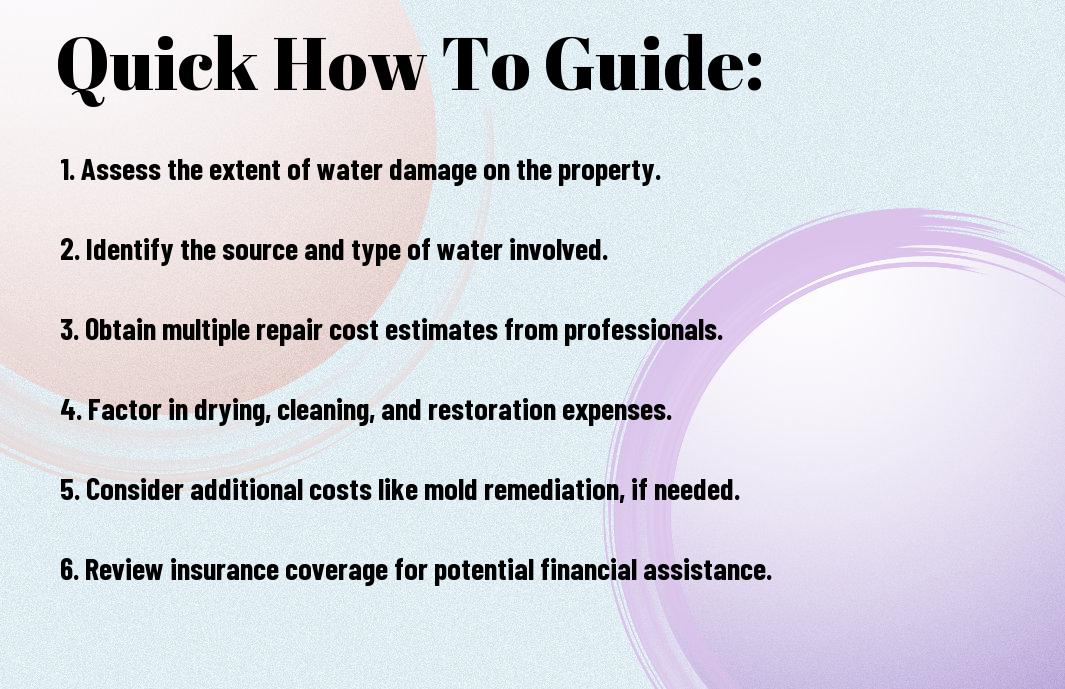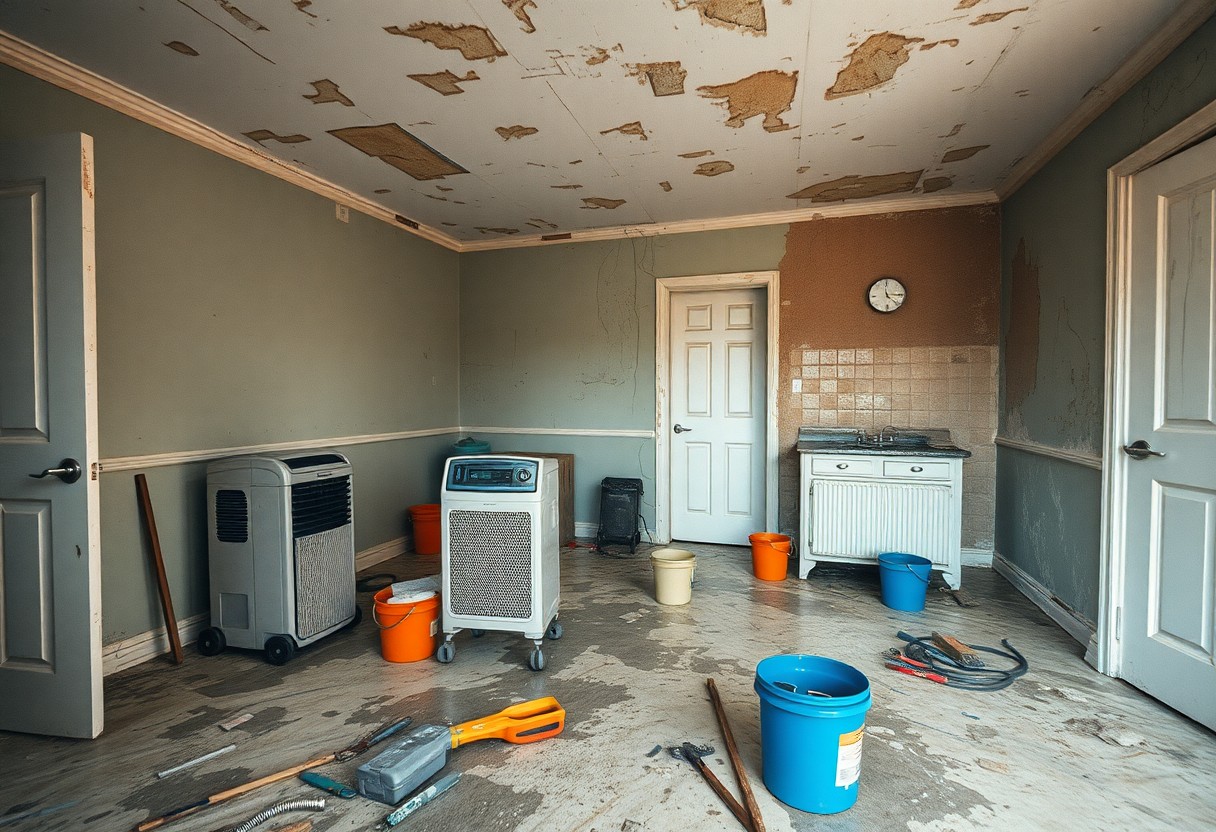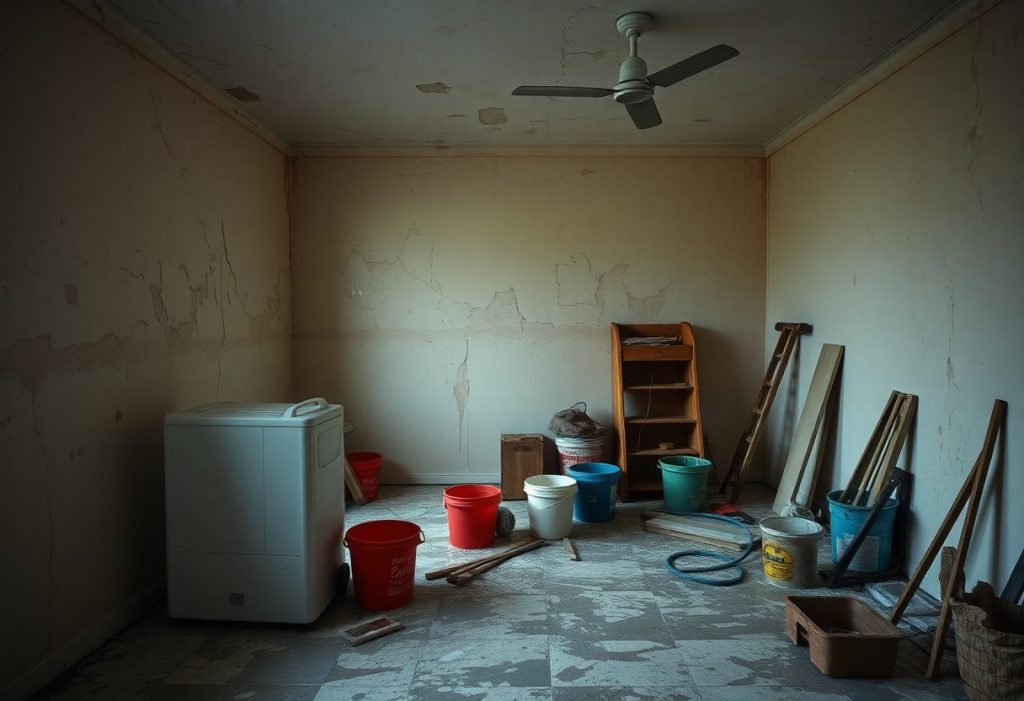Just when you think it can’t get worse, water damage can strike unexpectedly and lead to costly repairs if not addressed promptly. Understanding the potential costs associated with water damage repair is necessary for you as a homeowner. This guide will provide you with a clear breakdown of what factors influence repair costs, helping you make informed decisions as you restore your property and protect your investment. Let’s explore the various elements that contribute to the overall expense of water damage repairs.

The Cost Breakdown: What You’re Paying For
Your repair bill for water damage will typically consist of several key components. Understanding these elements helps clarify where your money is going and allows for more informed decision-making. Major costs include materials for repairs, labor expenses for skilled professionals, and specialized equipment usage. By breaking down these components, you can better anticipate your overall expenses and ensure that you’re not caught off guard by unexpected charges.
Materials and Labor Expenses
The largest portions of your repair costs usually stem from materials and labor. Common materials include drywall, insulation, paint, and flooring, which can add up quickly depending on the extent of the damage. Labor costs vary based on the complexity of the repairs and your location. On average, you might pay between $50 to $150 per hour for qualified professionals, with total labor costs ranging from hundreds to several thousand dollars based on the project’s size.
Equipment and Specialized Services
Utilizing professional services often involves specialized equipment such as dehumidifiers, moisture meters, and thermal imaging cameras. This equipment allows experts to assess damage accurately and efficiently dried out affected areas to prevent mold growth. These specialized services, combined with the equipment rental costs, can lead to additional fees that significantly impact your overall repair budget.

Factors Influencing Repair Costs
Various factors contribute to the overall cost of repairing water damage. These considerations can impact your budget and investment in restoration. Key influences include:
- The severity of water damage
- Your geographic location
- Market variability and demand
- The type of water involved (clean, gray, black)
Knowing these elements can help you understand and prepare for the possible expenses ahead. For more details on costs, check out How much does it cost to restore water damage?.
Severity of Water Damage
The extent of water damage significantly dictates repair costs. Issues classified as minor, such as surface water incidents, can be cheaper to fix, while substantial flooding or structural damage necessitates costly repairs and remediation efforts. Evaluating the categories of damage—ranging from cosmetic issues to severe structural threats—will help you estimate potential expenses accurately.
Geographic Location and Market Variability
Repair costs often vary as per geographic location. Urban areas typically face higher fees due to greater demand for restoration services and labor. Different local codes and regulations may also affect pricing. Understanding your specific region’s market can provide insight into what costs you might encounter.
Living in an area prone to natural disasters or high humidity can escalate costs due to increased demand for professional services. Moreover, some markets have more skilled labor and better resources, resulting in varied pricing structures from one locale to another. Be sure to research local pricing trends to glean a better picture of potential expenses.
Type of Water Involved (Clean, Gray, Black)
The type of water involved in the damage plays a critical role in the cost of repairs. Clean water, typically from a broken pipe, is less costly to address compared to gray or black water. Gray water includes wastewater from appliances, while black water originates from sewage, presenting health risks that necessitate extensive cleanup procedures.
Because of the potential hazards and specialized equipment required for restoring areas affected by gray or black water, repair costs can skyrocket. Therefore, it is crucial to identify the category of water involved early to strategize effectively on your restoration plan.

DIY vs. Professional Help: A Cost Comparison
| Cost Factors | Approximate Costs |
|---|---|
| DIY Supplies (mold remover, fans, dehumidifiers) | $100 – $500 |
| Professional Services (assessment and remediation) | $1,000 – $4,000+ |
| Time Commitment (hours to days) | Varies (likely higher for DIY) |
| Potential Structural Damage Risks | High with DIY |
Potential Savings and Risks of DIY
Undertaking water damage repairs yourself can lead to significant savings, as the costs associated with supplies may only range from $100 to $500. However, tackling the job alone carries risks of underestimating the damage or improperly handling hazardous materials, which could lead to more extensive repairs down the line. You might save money upfront, but those savings could evaporate if you end up causing further complications.
When to Call in the Experts
Professional help is often necessary when faced with extensive damage, significant structural concerns, or the presence of hazardous materials. Signs that it’s time to call in experts include severe water intrusion, mold growth, or if you are unsure about handling electrical components related to water damage. These situations demand specialized equipment and expertise to ensure safety and proper restoration.
For instance, if there’s standing water that exceeds a few inches or evidence of mold growth across large areas, attempting to manage it alone can be hazardous. Experts bring specialized training and equipment—such as moisture detectors and industrial-grade dehumidifiers—allowing them to identify hidden damage and mitigate health risks effectively. Engaging professionals not only reduces the likelihood of future issues but also guarantees a thorough and efficient restoration process.
Preventive Measures to Reduce Future Costs
Investing in preventive measures can significantly cut down future repair costs related to water damage. Simple steps like promptly addressing leaks, maintaining proper drainage, and using water alarms can help you avert extensive damages and corresponding repair bills. When considering the financial implications of water damage restoration, you might find yourself asking How much do they charge to repair a water damaged phone?. Proactively managing water risks is always more cost-effective than waiting for issues to arise.
Common Sources of Water Damage
Water damage can stem from a variety of sources within your home, including burst pipes, overflowing bathtubs, or malfunctioning appliances like dishwashers and refrigerators. Heavy rain or flooding can also contribute, particularly when it overwhelms your drainage system. Additionally, poorly sealed windows and roofs can allow water to seep in, leading to mold growth and structural issues.
Maintenance Tips to Mitigate Risks
Regular maintenance is vital to reduce the likelihood of water damage. Inspect your plumbing for leaks, clean gutters and downspouts, and ensure proper grading around your home’s foundation. It’s also wise to install sump pumps in flood-prone areas and check your home’s waterproofing systems. Recognizing these risks early can save you considerable stress and unnecessary expense down the line.
- Check appliances regularly for signs of wear or malfunction.
- Seal cracks and crevices in your home’s exterior promptly.
- Keep landscaping sloped away from your foundation.
- Inspect your roof periodically for missing or damaged shingles.
Addressing these maintenance tasks can be straightforward. By frequently inspecting appliances and plumbing, you might catch small leaks before they turn into larger issues. Regularly check the seals on windows and doors to ensure they’re watertight. Additionally, consider hiring a professional to assess your home’s drainage efficiency. Recognizing potential hazards early can prevent costly repairs later.
- Schedule annual inspections for your plumbing and roofing.
- Install a water alarm to alert you at the first sign of a leak.
- Teach your family about the signs of water damage.
Navigating Insurance Claims for Water Damage Repairs
Successfully navigating insurance claims for water damage repairs can significantly reduce your out-of-pocket expenses. Engaging with your insurer from the start is necessary to understand what coverage you qualify for and the steps required to initiate your claim effectively. Be prepared with detailed documentation, including photos of the damage, repair estimates, and any communications with your insurance company.
What’s Typically Covered in Policies
Homeowners insurance often covers damage from specific sources like burst pipes, leaking roofs, or appliance malfunctions. However, coverage can vary depending on the policy specifics, and it typically excludes floods unless you’ve purchased separate flood insurance. Reviewing your policy’s fine print helps you understand your coverage trends and find potential gaps that may need addressing.
Steps to Ensure a Smooth Claims Process
Initiating a water damage insurance claim requires careful steps for efficiency. Start by promptly notifying your insurer to prevent delays, and be sure to document all damage with photos and written descriptions. Obtaining detailed repair estimates from licensed professionals strengthens your position. Follow up regularly with your insurance agent to stay informed of your claim’s status, as persistent communication ensures you stay on track and helps expedite the process.
Detailed documentation is vital when filing your claim; create a comprehensive account of everything affected, including any damaged personal property. Keep track of all conversations with your insurer, noting dates, times, and what was discussed. This meticulous approach serves as your evidence should there be any disputes later on. Additionally, familiarize yourself with your state’s laws regarding claims processing timelines to hold your insurance company accountable. Consistent follow-up with your adjuster can also help resolve any lingering issues more swiftly, ensuring you get your claim settled without unnecessary delays.
Summing up
Upon reflecting, it’s crucial for you to understand that the cost to repair water damage can vary significantly based on factors such as the extent of the damage, the type of materials affected, and the necessary repairs. You could face expenses ranging from a few hundred to several thousand dollars. By being proactive in addressing water issues and consulting professionals, you can effectively manage and potentially minimize these costs, ensuring your home remains safe and sound.
Q: What factors influence the cost of water damage repair?
A: The cost of repairing water damage can vary significantly based on several factors. These include the extent of the damage, the type of water involved (clean, gray, or black water), the materials affected (drywall, flooring, etc.), and the location of the damage. Additionally, labor costs in your area, the need for specialized equipment or services, and whether mold remediation is necessary can all impact the final cost. On average, homeowners can expect costs to range from $1,000 to $10,000, depending on the severity of the damage.
Q: Is it worth it to hire a professional for water damage repair?
A: Hiring a professional for water damage repair is often advisable, especially for significant damage or when dealing with contaminated water. Professionals have the necessary equipment, expertise, and experience to assess the situation, carry out effective remediation, and prevent future issues like mold growth. While it is an additional expense, the long-term savings from avoiding structural damage and health risks often justify the investment. DIY repairs can sometimes exacerbate problems if not done correctly.
Q: What are the common costs associated with water damage repair?
A: Common costs involved in water damage repair include water extraction ($500 to $3,000), drying and dehumidification ($200 to $600), mold removal (which can range from $500 to $6,000), and repairs or replacement of damaged materials like drywall, flooring, or insulation. Each of these costs may vary based on the extent of the damage and the specific conditions of your home. It is imperative to get a detailed estimate and breakdown of these costs from a professional service to understand the total financial impact.

